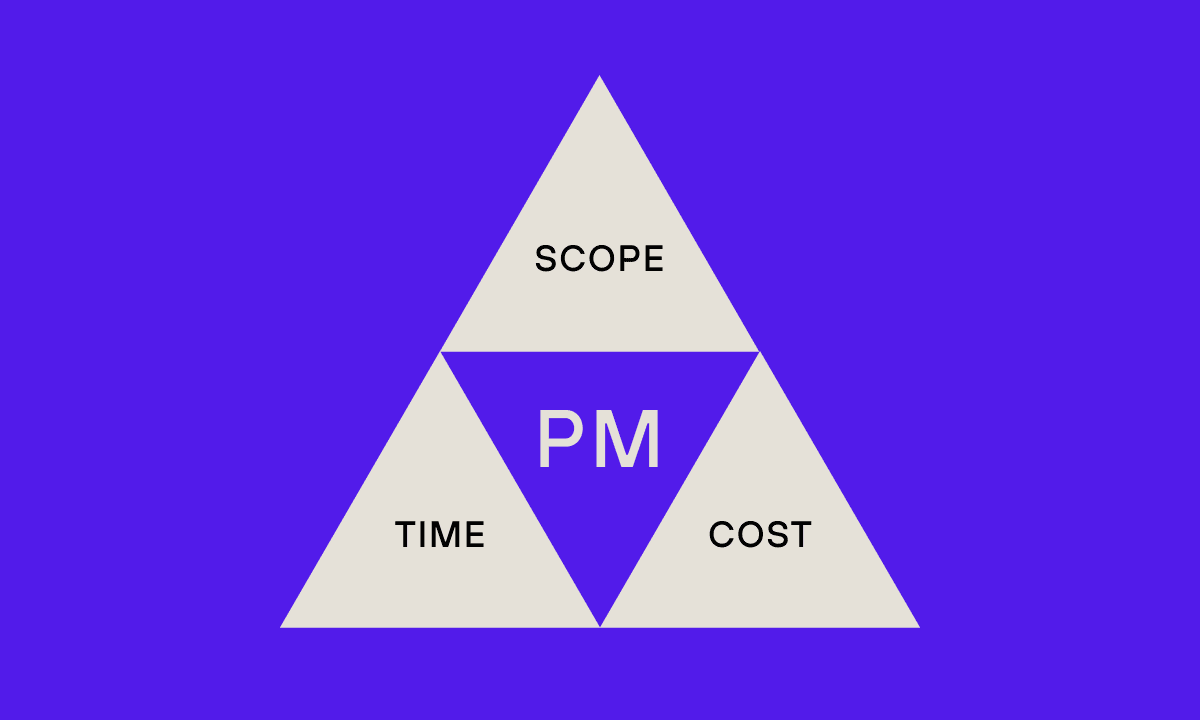
In the fast-paced world of project management, mastering the art of balancing time, cost, and scope is crucial for success. These three elements form the foundation of the Iron Triangle of Project Management.
This concept, also known as the Triple Constraint, represents the interdependence between time, cost, and scope in any project.
When it comes to time, this refers to the duration or timeline allotted for completing a project. It includes setting specific deadlines and milestones to ensure efficient progress.
On the other hand, cost represents the financial resources allocated to a project, including budgeting for materials, labour, and other expenses. Lastly, scope refers to the specific goals and deliverables that need to be accomplished within the given time and cost constraints.
The significance of the Iron Triangle of Project Management lies in its ability to provide a framework for project managers to make informed decisions and prioritise resources.
Balancing these three aspects is a delicate task, as changes to one side of the triangle can have a significant impact on the others. For example, if there is a need for additional features or functionalities (scope), it may lead to an increase in costs or a delay in the project timeline.
To manage the Iron Triangle effectively, project managers employ various strategies. One such strategy is prioritising project requirements. By identifying the most important aspects of the project, managers can allocate resources accordingly and ensure that the team remains focused on delivering the desired outcomes.
Additionally, agile methodologies have gained popularity in recent years as a way to navigate the challenges of the Iron Triangle of Project Management.
Agile approaches promote flexibility and adaptability, allowing project teams to respond to changes in scope, time, or cost more efficiently. This iterative approach encourages collaboration, feedback, and continuous improvement throughout the project lifecycle.
Despite careful planning and implementation, challenges can still arise during project execution. Two common obstacles are scope creep and unexpected delays.
Scope creep refers to the continuous expansion of project requirements beyond the initial scope, which can lead to budget overruns and missed deadlines. Managing scope creep requires clear communication, change control processes, and regular stakeholder engagement.
Similarly, unexpected delays can disrupt project timelines and impact costs. Project managers need to be proactive in identifying potential risks and developing contingency plans to mitigate their impact.
This includes building extra time buffers into the project schedule and maintaining open lines of communication with stakeholders.

Let’s explore the Iron Triangle of Project Management. Credit: George Bakos on Unsplash.
The Three Sides Of The Iron Triangle of Project Management
The three key elements of the Iron Triangle – time, cost, and scope – are critical factors that project managers must carefully consider and manage to ensure project success. Let’s take a closer look at each of these elements and their significance in project management.
- Time: This refers to the duration or timeline allocated for completing a project. It involves setting specific deadlines and milestones to ensure efficient progress. Effective time management is essential for keeping the project on track and meeting stakeholder expectations. Project managers must carefully plan and allocate resources to ensure tasks are completed within the designated time frame. They also need to monitor progress regularly to identify any potential delays and take appropriate actions to mitigate them.
- Cost: This represents the financial resources allocated to a project. It includes budgeting for materials, labour, and other project expenses. Managing cost involves estimating and controlling expenses to ensure they align with the available budget. Project managers must carefully track costs and make informed decisions about resource allocation to prevent budget overruns. Regular financial reviews and effective cost management strategies are crucial for keeping the project within budget and maximising the return on investment.
- Scope: This refers to the specific goals and deliverables that need to be accomplished within the given time and cost constraints. Clearly defining the project scope is essential for setting realistic expectations and avoiding scope creep. Project managers must work closely with stakeholders to understand their requirements and establish a clear scope statement. They need to ensure that project deliverables are well-defined and achievable within the project’s time and cost limitations. Regular scope reviews and effective change control processes help manage scope changes and prevent scope creep.
Balancing time, cost, and scope is a delicate task that requires effective project management skills. Changes to one side of the triangle can have a significant impact on the others. For example, increasing the scope of a project may lead to additional costs or a longer timeline.
It is essential for project managers to prioritise and make informed decisions to maintain equilibrium among these three elements.

Scoping is vital to the process. Credit: Airfocus on Unsplash.
How The Iron Triangle Can Make Or Break Your Project
When the Iron Triangle of Project Management is effectively managed, it can greatly contribute to project success. By carefully balancing time, cost, and scope, project managers can ensure that projects are delivered on time, within budget, and meet stakeholder expectations. This requires meticulous planning, effective communication, and proactive management throughout the project lifecycle.
However, if the Iron Triangle is not properly managed, it can lead to project failure. If one side of the triangle is compromised, it can have a ripple effect on the other two sides. For example, if the scope of a project expands without proper control, it can lead to delays and increased costs. Similarly, if the project timeline is not carefully managed, it can result in rushed work, compromised quality, and ultimately, a project that does not meet stakeholder expectations.
To prevent the Iron Triangle from breaking your project, project managers must prioritise and make informed decisions. This requires a deep understanding of the project’s objectives, stakeholder needs, and available resources. It also involves effective risk management, anticipating potential challenges, and developing contingency plans.
Moreover, effective communication and stakeholder engagement are crucial for managing the Iron Triangle. Stakeholders’ expectations and requirements can influence the project’s priorities and constraints. By keeping stakeholders informed and involved throughout the project, project managers can ensure that any changes or adjustments to the Iron Triangle are well-communicated and agreed upon.

Time. It’s a crucial factor in the Iron Triangle of Project Management. Credit: Luke Chesser on Unsplash.
The Role Of Stakeholders In The Iron Triangle
Stakeholders play a crucial role in the Iron Triangle of project management, as their expectations and requirements can significantly influence the balance between time, cost, and scope. Understanding and managing stakeholders’ expectations is essential for project managers to effectively navigate the complexities of the Iron Triangle and ensure project success.
Stakeholders can have different priorities and perspectives when it comes to the project’s objectives and constraints. Their expectations may vary based on their roles, interests, and the outcomes they anticipate. Therefore, it is crucial for project managers to actively engage and communicate with stakeholders throughout the project lifecycle.
By involving stakeholders from the early stages of the project, project managers can gain valuable insights into their expectations and requirements. This allows for a clearer understanding of the project’s scope, desired timeline, and available resources. By aligning stakeholders’ expectations with the Iron Triangle’s constraints, project managers can set realistic goals and avoid potential conflicts or misunderstandings later on.
Effective communication with stakeholders is key to managing their expectations and ensuring their involvement throughout the project. Regular updates, progress reports, and transparent communication channels help keep stakeholders informed about the project’s status, potential changes, and any impact on the Iron Triangle of Project Management. This allows stakeholders to provide feedback, make informed decisions, and adjust their expectations as needed.
Stakeholders’ involvement in decision-making processes is also crucial for managing the Iron Triangle effectively. By actively involving stakeholders in discussions about potential scope changes, timeline adjustments, or cost considerations, project managers can ensure that decisions are made collectively and in alignment with stakeholders’ interests. This collaborative approach helps build trust, fosters ownership, and reduces the risk of resistance or conflicts during the project execution.
Moreover, understanding stakeholders’ expectations can help project managers prioritise their efforts and allocate resources effectively. By identifying stakeholders’ priorities and preferences, project managers can make informed decisions about how to balance time, cost, and scope.
For example, if stakeholders prioritise a shorter timeline, project managers can allocate additional resources or adjust the scope accordingly to meet this expectation. Similarly, if stakeholders emphasise cost reduction, project managers can explore options for optimising resources or adjusting the timeline without compromising the project’s objectives.

Cost is another important factor. Credit: Joshua Hoehne on Unsplash.
Strategies For Managing The Iron Triangle Effectively
Managing the Iron Triangle of Project Management effectively requires the implementation of proven techniques that help maintain balance and achieve project goals. Here are some strategies that project managers can employ to ensure project success:
- Prioritise and align project objectives: It is essential to clearly define and prioritise project objectives based on stakeholder expectations and requirements. By aligning project goals with the Iron Triangle’s constraints, project managers can set realistic expectations and avoid conflicts later on.
- Establish clear communication channels: Effective communication is vital for managing the Iron Triangle of Project Management. Project managers should establish clear communication channels with stakeholders to keep them informed about project progress, potential changes, and any impact on the Iron Triangle. Regular updates and progress reports help maintain transparency and ensure stakeholders are actively involved throughout the project.
- Continuously monitor and assess project performance: Regular monitoring and assessment of project performance are crucial to identify any deviations from the Iron Triangle. Project managers should track key performance indicators, such as project timeline, budget, and scope, to ensure they are on track. This allows them to make informed decisions and take corrective actions promptly.
- Implement effective risk management: Anticipating potential risks and developing contingency plans are essential for managing the Iron Triangle. Project managers should conduct thorough risk assessments and develop mitigation strategies to address any potential threats to project success. This helps minimise the impact of unforeseen events and ensures that the project stays within its constraints.
- Foster collaboration and teamwork: Building a collaborative and cohesive project team is essential for managing the Iron Triangle effectively. Project managers should encourage open communication, establish a positive team culture, and promote collaboration among team members. This helps ensure that everyone is aligned with project goals and works together to overcome challenges and achieve success.
- Regularly review and adjust project plans: Project plans should be dynamic and adaptable to changes. Regularly reviewing and adjusting project plans based on evolving circumstances is crucial for managing the Iron Triangle of Project Management effectively. Project managers should be open to feedback, monitor the project’s progress, and make necessary adjustments to ensure project goals are achieved.
- Continuously improve project management practices: Project managers should strive for continuous improvement in project management practices. Learning from past experiences, evaluating project outcomes, and implementing lessons learned help enhance future project execution. By continuously improving project management practices, project managers can become more effective in managing the Iron Triangle and delivering successful outcomes.
By implementing these strategies, project managers can maintain balance within the Iron Triangle and achieve project goals while ensuring stakeholder satisfaction.
Effective management of time, cost, and scope is essential for project success, and these proven techniques can help project managers navigate the complexities of the Iron Triangle of Project Management and deliver successful outcomes.

It’s a hot seat for the project manager. Credit: Priscilla Du Preez on Unsplash.
The Rise Of The Fourth Side
Quality as the fourth side of the Iron Triangle of Project Management is an increasingly recognised and important concept in modern project management. Traditionally, the Iron Triangle consisted of time, cost, and scope as the three interconnected variables that determined project success.
However, the inclusion of quality as a fourth variable acknowledges the importance of delivering high-quality outcomes that meet or exceed stakeholder expectations.
In today’s competitive business landscape, simply meeting the predefined constraints of time, cost, and scope is not enough. Organisations and project managers are realising that delivering a quality product or service is crucial for the long-term success and sustainability of the project.
Quality encompasses various aspects such as functionality, reliability, performance, and customer satisfaction. It ensures that the end result not only meets the project objectives but also provides tangible value to the stakeholders.
By considering quality as a fourth side of the Iron Triangle of Project Management, project managers can make informed decisions and trade-offs when it comes to managing the project constraints.
They can balance the need for delivering on time and within budget with the requirement of maintaining a high level of quality. This shift in mindset allows project managers to prioritise quality throughout the project lifecycle, from planning and execution to monitoring and control.
Integrating quality into the project management framework also requires a proactive approach to risk management. Project managers need to identify potential quality risks and develop strategies to mitigate them.
This could involve conducting thorough testing and quality assurance activities, implementing quality control measures, or engaging stakeholders in quality management processes. By addressing quality risks early on, project managers can prevent costly rework, customer dissatisfaction, and negative impacts on the project.
Furthermore, the inclusion of quality as a fourth variable emphasises the need for continuous improvement and learning within the project team.
Project managers and team members should strive to enhance their skills, knowledge, and processes to deliver consistently high-quality outcomes. This can be achieved through regular performance evaluations, feedback loops, and lessons learned sessions.
By fostering a culture of quality, project managers can create a positive and collaborative environment that promotes excellence and drives project success.
To sum up, quality as the fourth side of the Iron Triangle is an essential concept in modern project management. It reflects the recognition that project success goes beyond meeting time, cost, and scope constraints.
By prioritising quality, project managers can deliver outcomes that not only meet stakeholder expectations but also provide long-term value. Integrating quality into the project management framework requires proactive risk management, continuous improvement, and a focus on customer satisfaction.
By embracing quality as a core component of the Iron Triangle of Project Management, project managers can set their projects up for success and ensure the achievement of desired outcomes.

The vital word in all of this. Credit: Octavian Dan on Unsplash.
The Future Of The Iron Triangle In Project Management
As project management practices continue to evolve and adapt to new challenges and demands, the concept of the Iron Triangle of Project Management is also undergoing changes.
In today’s dynamic and fast-paced business environment, project managers are increasingly facing the need for flexibility and agility in managing projects.
This has led to the emergence of new trends and potential changes to the traditional model of the Iron Triangle.
One of the most significant trends in project management is the growing emphasis on stakeholder value and outcomes. While time, cost, and scope are still critical factors in project success, they are no longer the sole determinants.
Project managers are now also considering factors such as quality, customer satisfaction, and sustainability when evaluating project performance.
This shift in focus reflects a broader recognition that project success is not just about meeting the predefined constraints but also about delivering real value and achieving desired outcomes for all stakeholders.
Another trend that is shaping the future of the Iron Triangle of Project Management is the increasing use of agile and iterative project management methodologies.
Traditional project management approaches often follow a linear and sequential process, where each phase is completed before moving on to the next. In contrast, agile methodologies promote a more iterative and adaptive approach, allowing for continuous feedback, collaboration, and adjustments throughout the project lifecycle.
This iterative approach enables project teams to respond quickly to changes, embrace evolving requirements, and deliver incremental value to stakeholders. As a result, the traditional fixed relationship between time, cost, and scope becomes more flexible, allowing for greater adaptability and responsiveness.
Furthermore, the rapid advancement of technology is also influencing the future of the Iron Triangle of Project Management. With the advent of powerful project management software and tools, project managers now have access to real-time data, analytics, and automation capabilities.
These technological advancements enable project managers to track and monitor project progress more effectively, identify potential risks and issues early on, and make data-driven decisions.
This increased visibility and control over project performance can help project managers better manage the variables of time, cost, and scope, and make informed adjustments when needed.
Another potential change is the shift towards a more holistic and integrated approach to project management. Traditionally, the Iron Triangle has been viewed as a set of separate and independent variables.
However, as projects become more complex and interconnected, project managers are realising the need to consider the interdependencies and trade-offs between time, cost, scope, and other project dimensions.
This holistic approach acknowledges that changes in one variable can have ripple effects on others and requires a more integrated and collaborative approach to project management.
The future of the Iron Triangle of Project Management is being shaped by evolving trends and potential changes to the traditional model.
The growing emphasis on stakeholder value and outcomes, the adoption of agile and iterative methodologies, the influence of technology, and the inclusion of quality as a fourth variable are all contributing to a more flexible and adaptive approach to managing projects.
Project managers who embrace these changes and adapt their practices accordingly will be better equipped to navigate the complexities of modern project management and deliver successful outcomes.

Tracking progress is essential. Credit: Linkedin Sales Solutions on Unsplash.
Looking for Outside Help?
Are you preparing to launch your amazing product or service – or do you just want to grow your business – and need marketing, branding, and sales support to get it off the ground?
At Hunt and Hawk, we’re experts in these fields. Get in touch with us today:


